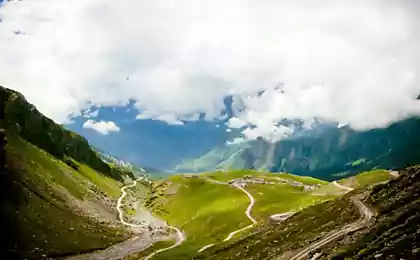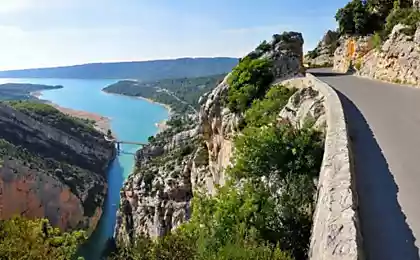812
Appian Way (15 photos)
The author writes, via cicerone2007.livejournal.com:
"And now, as then, coming to Rome traveler to part with one world and finds another. The eternity of Rome is not fiction - it is surrounded by country, over which time has stopped its flight and the wings folded. Historic day never came here, there dawns the dawn of our existence ».
P.P.Muratov. "Images of Italy»
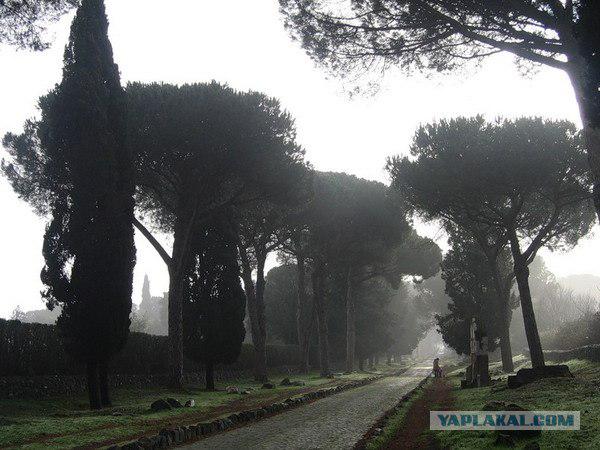
Ancient Rome, in contrast to ancient Greece, I fell in love immediately, the first year. Forever imprinted in the memory of the main images of Rome, among them one of the most important are the stones of the Appian Way. His first conscious, not accidental traveling abroad I made in Italy. Then from the bus window, I saw the Queen of the road for the first time. Only stones were not, because in this region, it was covered with asphalt. The long-awaited walk on the Appian Way was held even during my fourth visit to Rome.
We got on a bus to Capo di Bove (referred to as the tomb of Cecilia Metella, because it zoster frieze depicts the head of bulls), and went for a morning desert road, bordered by pine trees and cypresses, in the direction of Rome. That's the real gems:
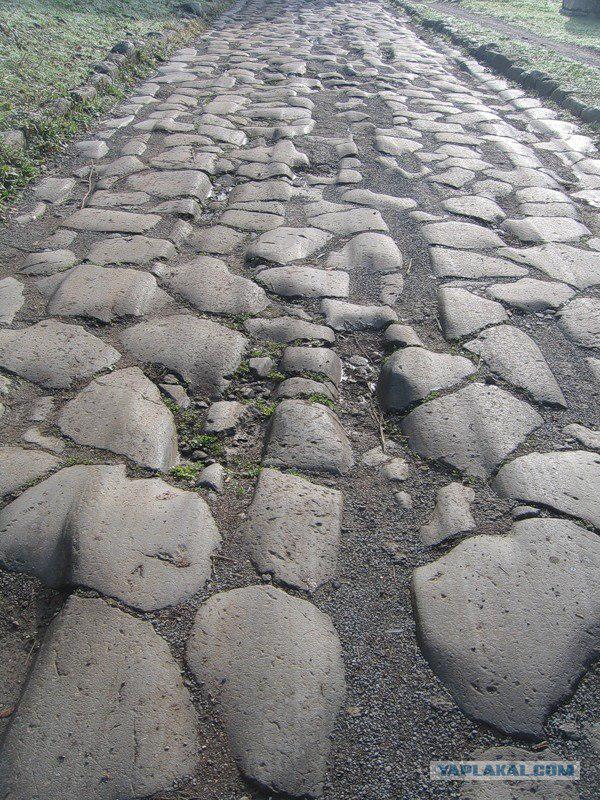
"In 312 BC. e., when Rome was the censor Appius Claudius, built water and roads; Both of these facilities have kept his name forever.
The Romans called the Appian Way (Via Appia) the queen of roads, since it was the first stone-paved road in the history of Italy; it led to the south and joined first Rome with Capua, and then it continued to Benevento and Brindisi. After III - II at the beginning. BC. e. it improved, giving it structure, preserved to this day: a well-compacted earth poured concrete of fine gravel with a strong cement on top put another layer of concrete with gravel and the second layer, while it has not yet solidified, put the smooth large basalt slabs, sinking their foundation in rough concrete. This three-layer structure having a slight bulge in the center (to keep the water running down the edges of the road), reaches a height of 90 cm (thickness of the modern highway no more than 60-70 cm). For centuries, the Romans built many roads; time has shown that their longevity is a hundred times higher than that of our highways. Appia, the oldest of them all, still works, but now it almost everywhere basalt slab poured asphalt, and it is called Antica (ancient) as opposed to new laid parallel to it (via Appia Nuova); road connecting them, called the via Appia Pignatelli, so now the Eternal City has three of the Appian Way.
Along the old "Queen of the Road" in due course we built a lot of mausoleums, because Rome had to liquidate overcrowded cemeteries in the city, and the dead were buried along the roads ».
E.V.Fedorova. Famous places in Italy.

The first house we met, immediately drew attention to its walls made of stones, broke down the old tombs of:

...
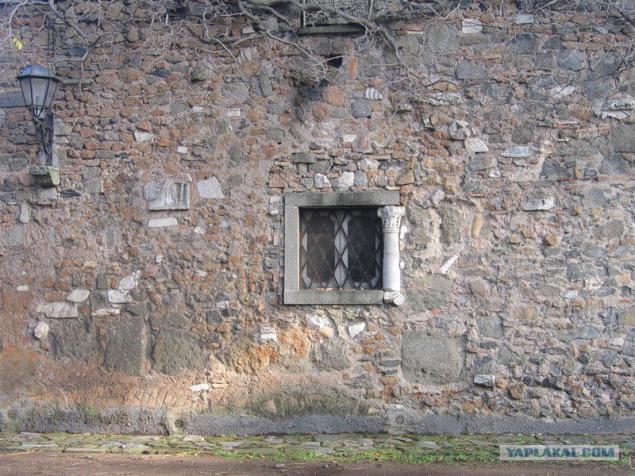
And then began to appear tomb. That tomb Hillary Fusco with five portraits:

That's Tomb and the Tomb of Garlands frontispiece:

And this tomb stele called Heroic relief. Behind him is a military unit:
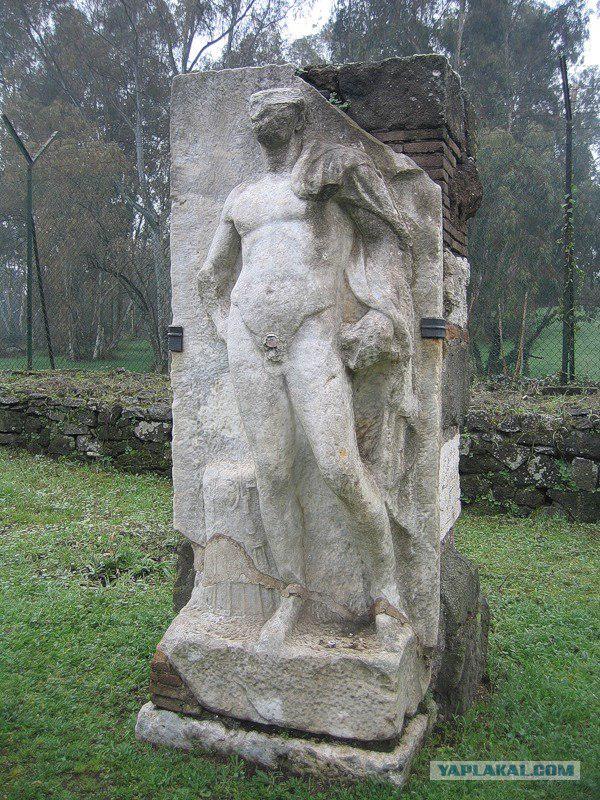
Dedicatory inscription preserved tomb of Sixtus Pompey Fair servant, got freedom in 1 .:
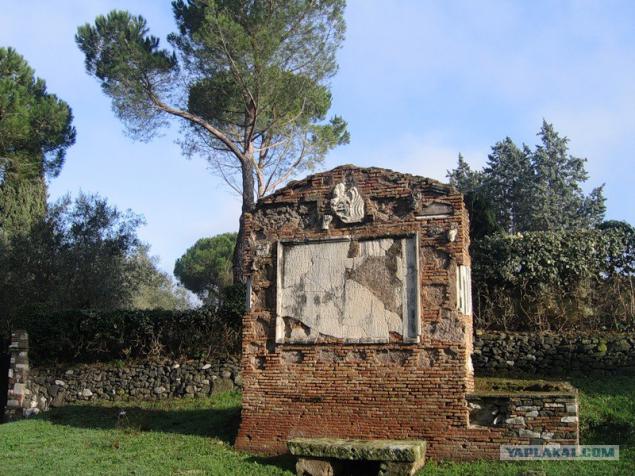
We marched a few kilometers down the road, enjoying the fresh fields, pine trees and cypresses, enjoying the seclusion of and silence. Then he turned back to look more closely at the mausoleum of Cecilia Metella:

This squat tower 1. BC, marble, once probably had tapered finish. He broke in the Middle Ages, when the mausoleum was a part of the Castle Caetani, and was used as a fortress tower. It was then that there were "dovetails»:

The remains of the wall of the tomb mounted reliefs, and in the mausoleum arranged a small museum:

Near the tomb of Cecilia Metella in 312, Emperor Maxentius built a huge circus. His arena has a length of 482 m and a width of 79 m. Around the arena artificial substructure located ten rows for spectators. They could be 15 thousand:
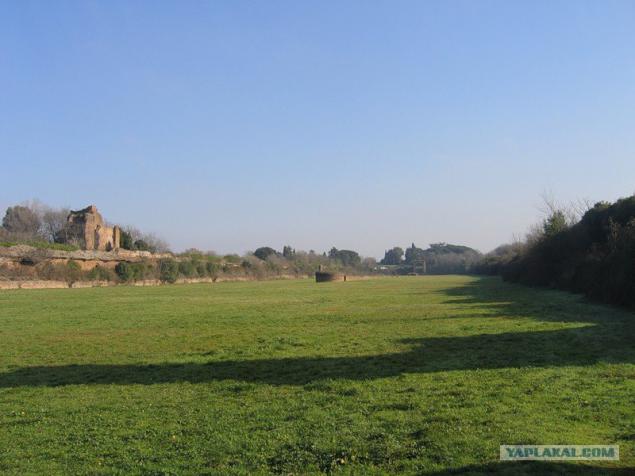
Between the towers, which are partially preserved, were punishment cells - the starting stalls for horses:

On the same stretch of road are and Christian monuments. Unfortunately, we did not get the catacombs, but admire the ruins of the Gothic church of St. Nicholas could ...
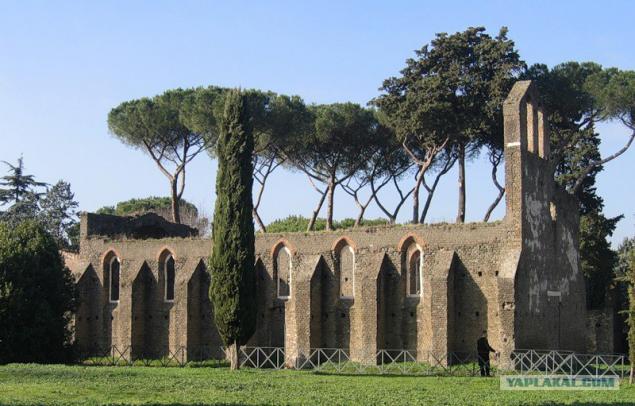
Source:
"And now, as then, coming to Rome traveler to part with one world and finds another. The eternity of Rome is not fiction - it is surrounded by country, over which time has stopped its flight and the wings folded. Historic day never came here, there dawns the dawn of our existence ».
P.P.Muratov. "Images of Italy»

Ancient Rome, in contrast to ancient Greece, I fell in love immediately, the first year. Forever imprinted in the memory of the main images of Rome, among them one of the most important are the stones of the Appian Way. His first conscious, not accidental traveling abroad I made in Italy. Then from the bus window, I saw the Queen of the road for the first time. Only stones were not, because in this region, it was covered with asphalt. The long-awaited walk on the Appian Way was held even during my fourth visit to Rome.
We got on a bus to Capo di Bove (referred to as the tomb of Cecilia Metella, because it zoster frieze depicts the head of bulls), and went for a morning desert road, bordered by pine trees and cypresses, in the direction of Rome. That's the real gems:

"In 312 BC. e., when Rome was the censor Appius Claudius, built water and roads; Both of these facilities have kept his name forever.
The Romans called the Appian Way (Via Appia) the queen of roads, since it was the first stone-paved road in the history of Italy; it led to the south and joined first Rome with Capua, and then it continued to Benevento and Brindisi. After III - II at the beginning. BC. e. it improved, giving it structure, preserved to this day: a well-compacted earth poured concrete of fine gravel with a strong cement on top put another layer of concrete with gravel and the second layer, while it has not yet solidified, put the smooth large basalt slabs, sinking their foundation in rough concrete. This three-layer structure having a slight bulge in the center (to keep the water running down the edges of the road), reaches a height of 90 cm (thickness of the modern highway no more than 60-70 cm). For centuries, the Romans built many roads; time has shown that their longevity is a hundred times higher than that of our highways. Appia, the oldest of them all, still works, but now it almost everywhere basalt slab poured asphalt, and it is called Antica (ancient) as opposed to new laid parallel to it (via Appia Nuova); road connecting them, called the via Appia Pignatelli, so now the Eternal City has three of the Appian Way.
Along the old "Queen of the Road" in due course we built a lot of mausoleums, because Rome had to liquidate overcrowded cemeteries in the city, and the dead were buried along the roads ».
E.V.Fedorova. Famous places in Italy.

The first house we met, immediately drew attention to its walls made of stones, broke down the old tombs of:

...

And then began to appear tomb. That tomb Hillary Fusco with five portraits:

That's Tomb and the Tomb of Garlands frontispiece:

And this tomb stele called Heroic relief. Behind him is a military unit:

Dedicatory inscription preserved tomb of Sixtus Pompey Fair servant, got freedom in 1 .:

We marched a few kilometers down the road, enjoying the fresh fields, pine trees and cypresses, enjoying the seclusion of and silence. Then he turned back to look more closely at the mausoleum of Cecilia Metella:

This squat tower 1. BC, marble, once probably had tapered finish. He broke in the Middle Ages, when the mausoleum was a part of the Castle Caetani, and was used as a fortress tower. It was then that there were "dovetails»:

The remains of the wall of the tomb mounted reliefs, and in the mausoleum arranged a small museum:

Near the tomb of Cecilia Metella in 312, Emperor Maxentius built a huge circus. His arena has a length of 482 m and a width of 79 m. Around the arena artificial substructure located ten rows for spectators. They could be 15 thousand:

Between the towers, which are partially preserved, were punishment cells - the starting stalls for horses:

On the same stretch of road are and Christian monuments. Unfortunately, we did not get the catacombs, but admire the ruins of the Gothic church of St. Nicholas could ...

Source:















